Call center attrition: How to lower turnover and boost retention

Customer Support Manager - Tier 1
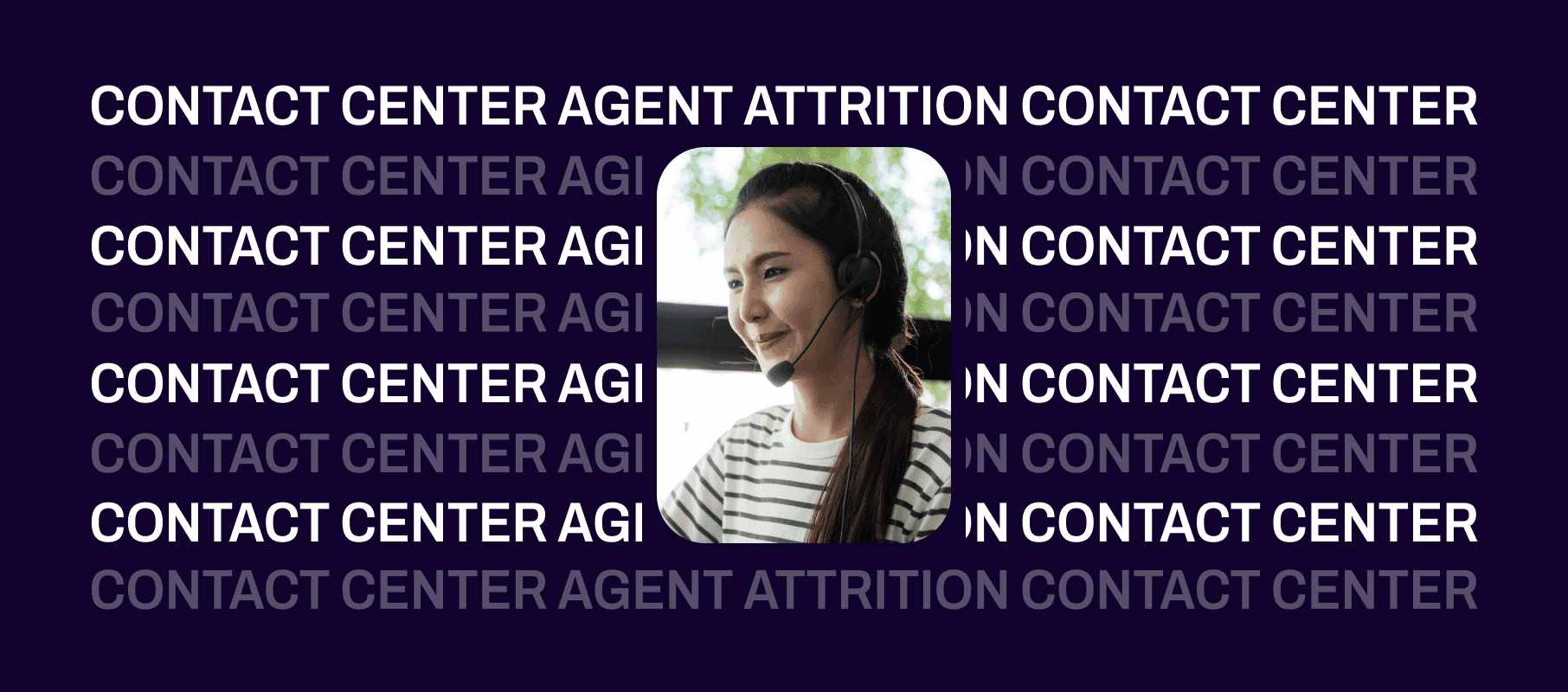
Tags
Share
Employee attrition affects all industries, but you’ve probably heard that it's particularly high in call centers and contact centers. That’s not a surprise, given the emotionally taxing work in contact centers (which leads to burnout and difficulty in achieving work-life balance), but that doesn’t mean that it’s inevitable.
And it shouldn’t be! High call center attrition rates can cost companies thousands of dollars in recruitment and training for new employees. It also leads to lost productivity and staff shortages, which puts a strain on your remaining agents, not to mention the negative impact on your customer experience. All of which affects your bottom line.
In this guide, we’ll look at the main causes of call center attrition and the steps you can take to reduce it, retain more contact center agents, and give your customers world-class service.
What is the average turnover rate for call centers?
Depending on where you're getting your stats from (and how old they are), you might see quotes of anywhere from 30 to 45% (this is probably the most-quoted stat from Quality Assurance and Training Connection, even though it's from 2015). Another survey found that turnover rate in call centers was 42% in 2021. So things haven't really changed.
Calculating the average turnover rate for a call center
Call center turnover rates have always been high compared to other industries. But they vary depending on factors like call center size and agent position. In general, the larger the company, the higher the attrition rate.
Calculating call center attrition at least once a year to see how it changes over time is good practice. It’s also a great way to see if your retention strategies are paying off. You can use the following formula:
Call center attrition rate = (Total number of agents leaving / Average number of employees) × 100
For example, say you’ve got the following results for your contact center over the year:
Month | Number of leaving agents | Total number of agents |
January | 4 | 89 |
February | 9 | 87 |
March | 6 | 87 |
April | 2 | 82 |
May | 5 | 88 |
June | 8 | 85 |
July | 7 | 81 |
August | 11 | 79 |
September | 6 | 84 |
October | 3 | 89 |
November | 4 | 86 |
December | 2 | 87 |
Total/Avg: | 67 | 85.3 |
Using the call center attrition formula, we can calculate turnover: (67 / 85.3) x 100. In this example, agent attrition is 78.6%. Yikes!
You can also break it down for a more detailed picture. For example, you could look at whether turnover is internal (to another position within the company) or external (to a different company). You could argue that internal turnover is slightly less damaging as it means you’re not completely losing your investment in that employee.
Why do call centers have a high turnover rate?
If you take a cursory look at job descriptions on LinkedIn or a contact center job board, you’ll notice that many call center agent jobs tend to be entry-level positions with low salaries. They also involve a lot of repetitive一and often stressful一conversations with customers. This combination of low pay and high stress is a leading cause of the high attrition rates common in call centers.
Contact center agents may view their jobs as a “bridge” job that they’re taking while they work toward another job that they went to school for or that they’d rather do. Because of this, there’s a seemingly continuous cycle of employees leaving the contact center industry for better pay, greater flexibility, and more advancement opportunities.
So, if managing attrition is important to you, then you may make it part of your contact center management strategy to create a more attractive place to work and engage agents to increase retention.
Reasons for attrition in call centers (+ solutions)
Reason #1: The technology hinders rather than helps them
Traditional call center technology is pretty far from cutting edge and for a long time, that was okay. Agents punched in, plugged in their headsets, answered calls, and punched out.
Today, however, the internet and social media have given way to more personalized interactions with customers and much higher expectations of service. The stakes for meeting (or not meeting) those expectations have gotten higher too, with more and more customers leaving companies for competitors over bad service.
And since the pandemic, there are also more and more remote agents—who now have to do more than just answer a phone call—they need to know the customer's history, where they’re struggling, and how to quickly and efficiently offer support. And they have to do this across multiple channels like social media and live chat too!
To make all of this easier, it helps if you equip your agents with the right tools. Pandemic or not, if you have a distributed team of contact center agents, it should be easy for them to manage all their customer interactions across different channels and get real-time coaching. And for your supervisors, it should be easy to do quality assurance and oversee multiple active calls simultaneously.
Solution:
Equip your team with modern contact center technology. For example, we use Dialpad’s omnichannel contact center platform to do exactly that. Not only can agents manage phone calls, WhatsApp messages, SMS messages, and more in one platform:

Dialpad Ai also transcribes calls and analyzes sentiment in real time, which helps managers quickly see if an agent needs help, get more context, and decide if they need to jump into the call:

Not only does this empower our agents to do their jobs more effectively, it also helps us improve the customer experience. Win-win.
Reason #2: There's no clear path to success
What metrics are you currently using to track agent performance? First Call Resolution (FCR)? CSAT scores? Handle time?
Which metrics have priority over the others? Your agents should know the answers to these questions.
When there's confusion about how your metrics align to your team's goals and your overall organizational goals, agents can be left feeling frustrated, burnt out, or ready to look for a new job.
Solution:
Make sure everyone understands your call center KPIs, and boil that down into operational benchmarks you can apply across your call centers and support agents so that everyone has a common goal to work towards. Whether you have an in-house team or run an outsourcing operation, this is critical.
📚 Further reading:
Learn more about BPO (business process outsourcing).
Reason #3: Agents have limited onboarding or coaching
It's pretty common for new agents to have next to no experience when joining a contact center or call center. So, unless you're working with a team of seasoned pros, your agents probably need a little more help than you originally anticipated.
Trouble is, managers don't always have the best means to train agents or capture coachable moments. Whether that's because of the technology they're using (see reason #1), or simply the number of agents they're responsible for, there can be a variety of different reasons why agents don’t always get the coaching they need.
It may not seem like a big deal, but over time, this lack of training and empowerment can lead to low morale and performance—and ultimately, employee turnover.
Solution:
Effective call center coaching goes beyond teaching agents how to use your tools and offering empathy when they’ve had a rough day.
You need real-time customer insights (what are the most common questions that customers are asking?) in order to know how you can provide better training and materials for your agents.
For example, we can create “Custom Moments” in Dialpad to track how frequently certain topics or keywords come up in calls. Let’s say I notice that we’ve been getting lots of tough questions lately about a new feature, Feature X. I can monitor how frequently this comes up by creating a Custom Moment:
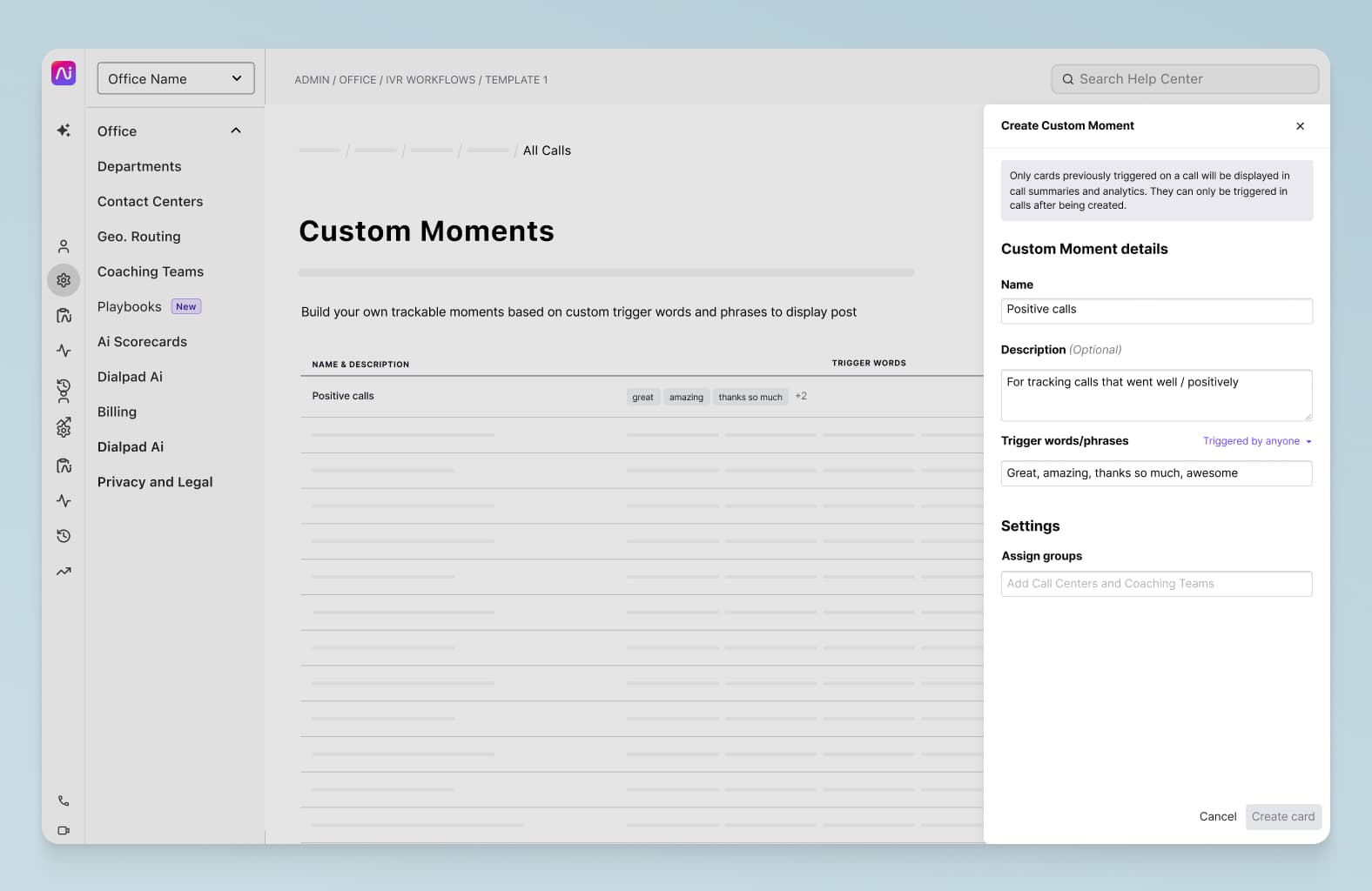
Then, I can just check out Dialpad’s built-in contact center analytics to see if there are any spikes or strange patterns:
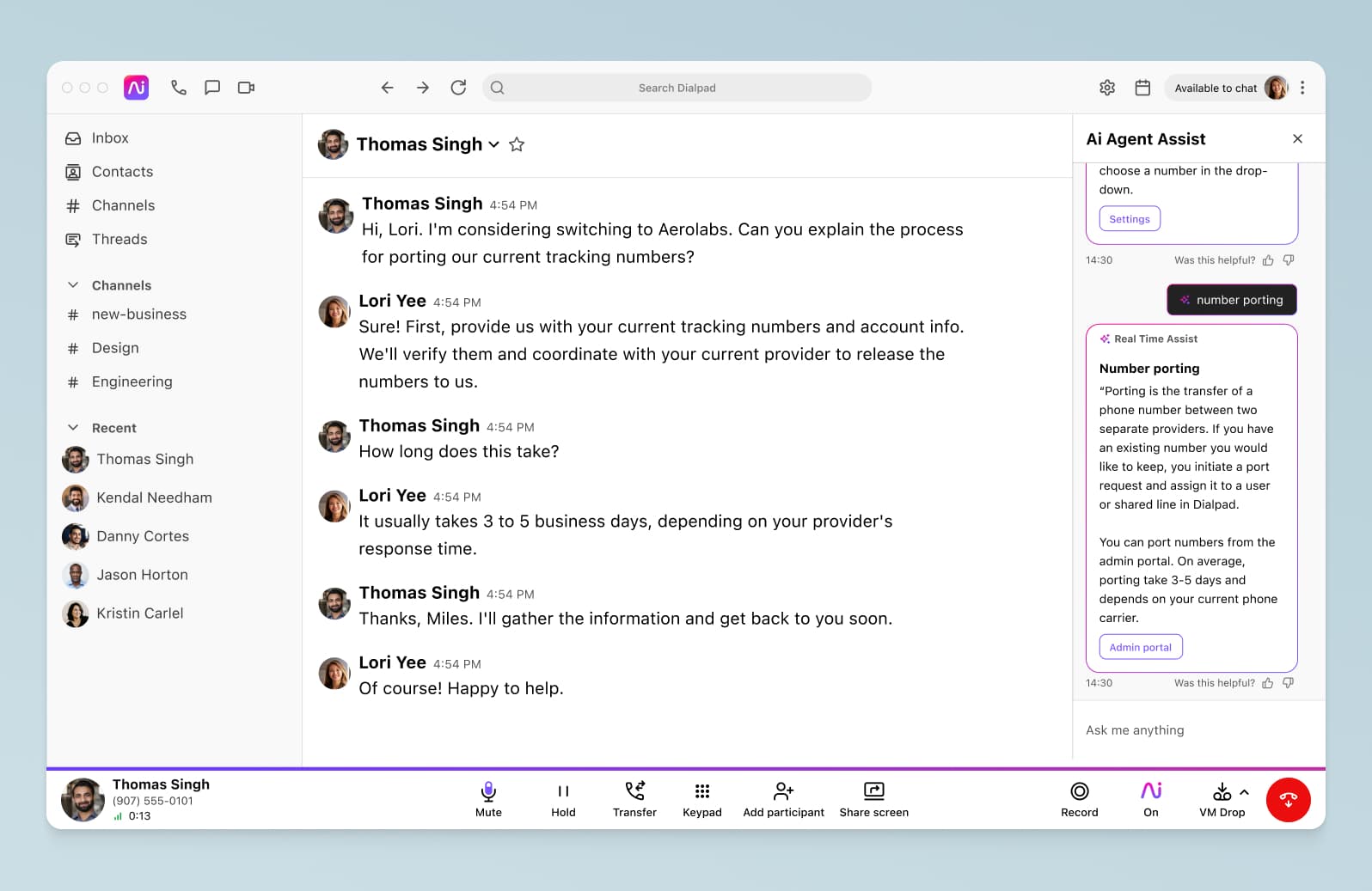
If I do notice a spike in questions about Feature X, I can then use this knowledge to create a Real-Time Assist (RTA) card with tailored notes on how to talk about Feature X—and set that to trigger on agents’ screens whenever “Feature X” is spoken on a call!
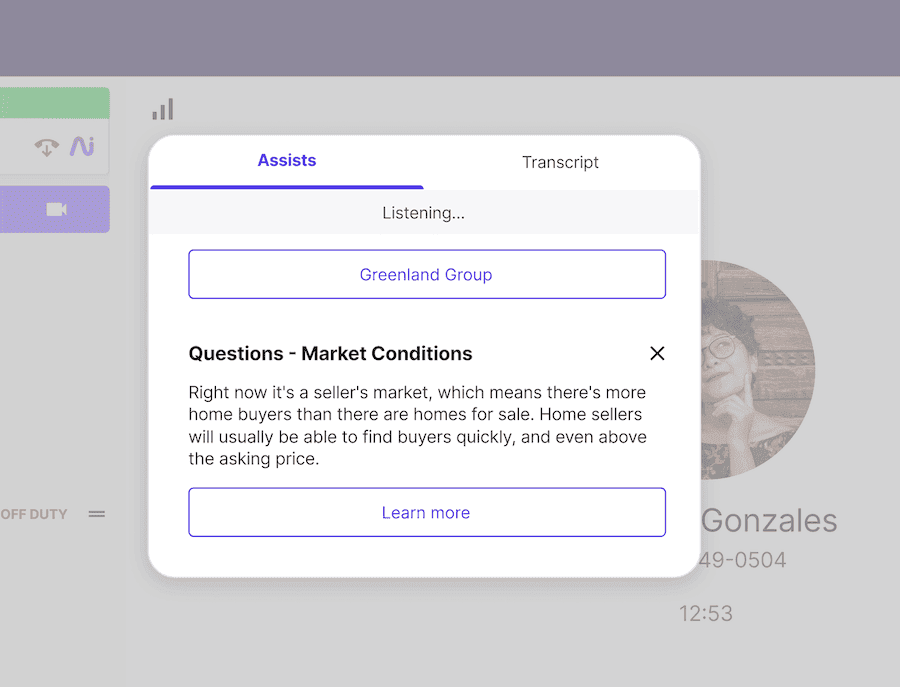
In a remote work environment, this type of AI-powered coaching is crucial because supervisors can’t just walk around the office and help agents in-person. This way, I don’t have to personally coach every call, and my agents can get the information they need to handle customer questions.
5 ways to improve agent retention in call centers
1. Have a solid training program
Training programs have always been important, but ever since the pandemic pushed many businesses to move to a remote work environment, it’s been even more crucial.
Not only does a good training program empower your call center agents and new hires to do their jobs well, it also has other benefits like improving employee retention, building company culture, and more. (Even if you run a BPO or outsourced operation.)
Make sure you have an onboarding program for new hires that teaches them about the products or services that they’ll be providing support for, and more importantly, make sure there are opportunities for ongoing training and development opportunities too.
For example, we use Dialpad’s contact center platform, which has a neat Spotify-esque playlist feature that lets us add call recordings of the best (and worst!) calls for agents to learn from on their own time:
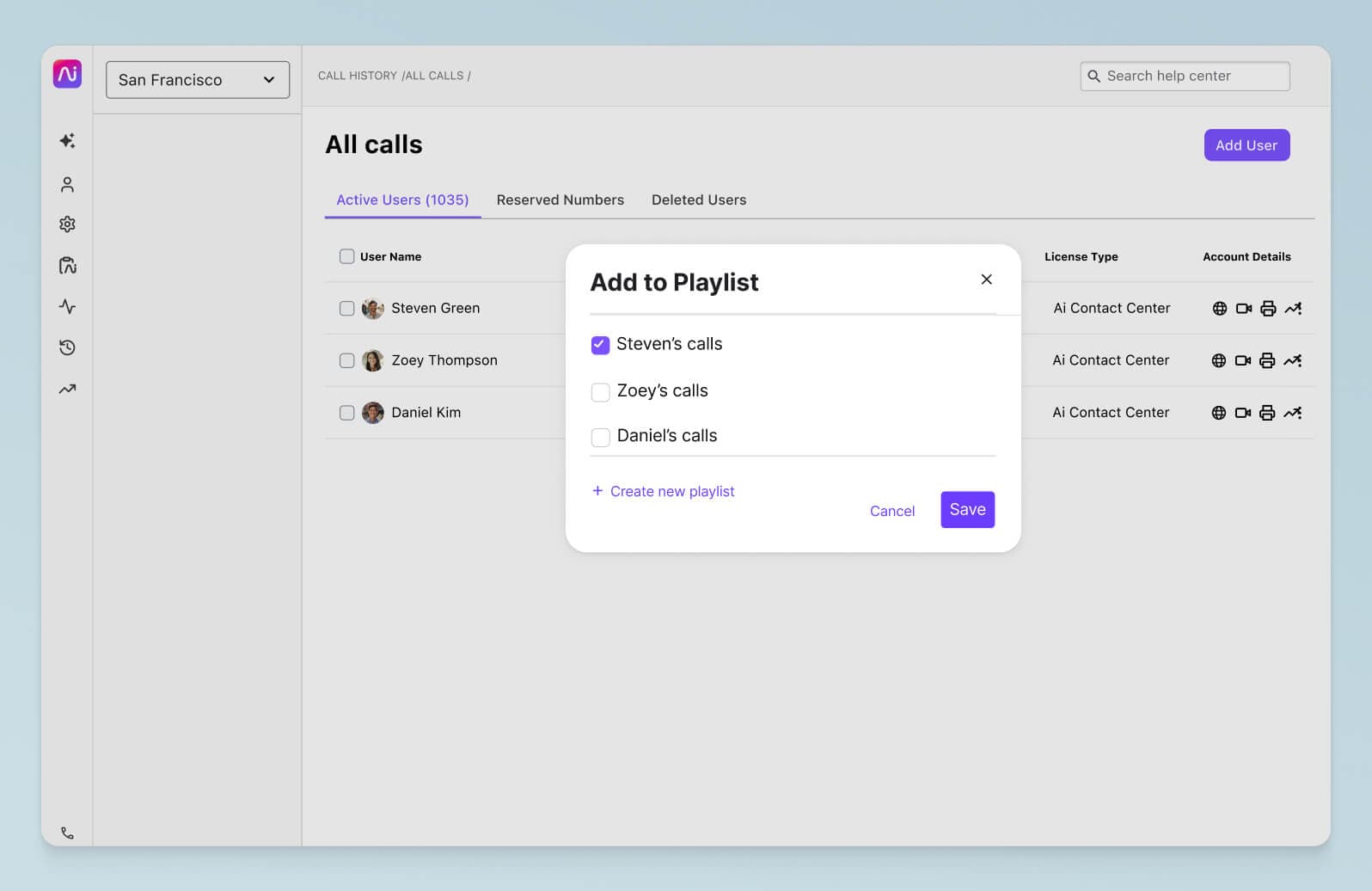
2. Monitor metrics regularly
If you’re like most call center managers, you’re likely already tracking metrics like average speed to answer and customer satisfaction (CSAT).
But what does this have to do with retention? For me, tracking metrics gives me insight into where agents are doing well, and where they can use more support. (Plus they help you pinpoint problems and improve the quality of your customer interactions.)
When you do quarterly or annual reviews with agents, this helps you have more constructive conversations and point out specific examples of what they’re doing great at (“Your CSAT scores improved by 25% this year!”) and how they can improve.
No call center agent is perfect, but it’s not helpful if you just tell them their CSAT scores are terrible, without also giving them advice on how to improve.
For example, one of the biggest challenges by far with CSAT scores is that not a lot of respondents actually fill out those surveys.
In fact (depending on the industry and specific business of course), we've found that on average only about 5% of customers actually fill out CSAT surveys. On a related note, usually only the angriest—and happiest—customers actually bother to respond to these surveys, which means your CSAT answers are likely to be very skewed and not representative of how your customers feel overall. This can be stressful for agents, because this is a huge performance metric and this shortcoming of CSAT can reflect on them unfairly.
Dialpad's industry-first Ai CSAT feature is designed to solve exactly that. Not only can our Ai transcribe calls and analyze sentiment in real time, it can also infer CSAT scores for 100% of your customer calls thanks to its hyper-accurate transcription feature. The result? A much more representative sample size for CSAT scores, and a more accurate performance metric for your contact center agents:

This is an example of how you can use and gather metrics more strategically to truly help your agents—and reduce call center attrition.
3. Provide appropriate recognition and rewards
Call center employees are regularly under a lot of stress, and besides providing salary and compensation, it’s nice to recognize and reward their achievements from time to time. It could be a bonus or a gift for particularly outstanding work, but this is an important piece of the puzzle if you’re experiencing attrition issues.
It’s important to note that this is best as a supplementary piece of your retention strategy. If your agents aren’t satisfied with other aspects of the job, or aren’t supported with the right tools, just relying on bonuses or telling them “good job” isn’t going to cut it when it comes to employee engagement.
4. Provide opportunities for promotion
Another way to reduce call center attrition rates is to provide clear advancement opportunities. If agents can’t see a clear development path, it makes it harder to stay motivated to work hard and envision themselves at your company over the long term. (You’d feel the same way too!)
As part of your training program, you could offer agents the chance to learn the skills to become team leaders or supervisors. Whatever their interests, take time to nurture them and help them plan their future career path. That way, they’re more likely to stick around.
5. Equip them with the right software and tools
Your agents can have all the soft skills in the world, but having a good contact center platform can make their jobs a lot easier. From automating repetitive tasks to reducing the amount of data entry and helping them get answers to tricky questions more quickly, there’s a lot that technology can do to help your agents.
What if an agent could handle all their customer conversations in one convenient app? Or, what if they could quickly message their supervisor to get help with a customer? (If you’ve ever been frustrated by having to toggle between five or six different apps to find the right answers for a customer, or not having enough wrap-up time because you had way too many notes to type up after a call, then you’ll understand why it’s so important to provide a good agent experience!)
Address your call center attrition before it's too late
High attrition is common in the call center industry. There’s no doubt about that. But there are things you can do to keep your skilled agents around.
Ongoing training is a great way to build camaraderie, good compensation, and providing a clear path to promotion can all help you improve your agent experience and employee retention.
If you are looking for a contact center platform that can support your agents and supervisors, why not check out Dialpad Ai Contact Center and see how it supports our own Customer Experience and Sales teams?
Empower agents and provide better customer experiences
See how Dialpad Ai Contact Center is designed to help you do exactly that. Book a demo or take a self-guided interactive tour of the app!








